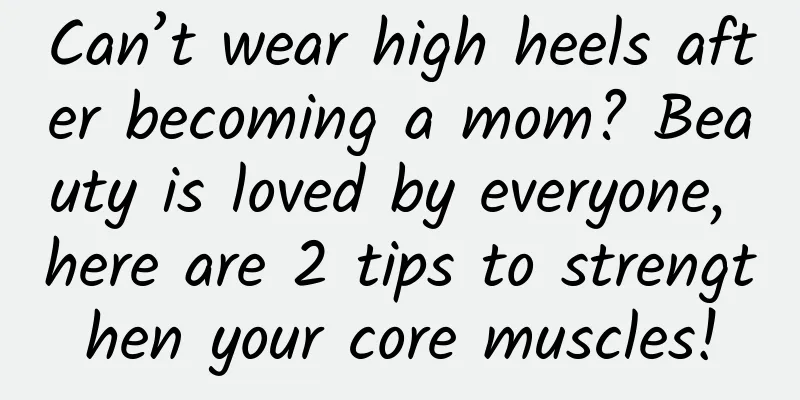Can’t wear high heels after becoming a mom? Beauty is loved by everyone, here are 2 tips to strengthen your core muscles!

|
Women who love beauty have a love-hate relationship with high heels. Wearing high heels not only makes the figure look taller, but also lengthens the leg proportions and lines. However, if you don’t know how to wear the shoes, your calves and feet will feel sore after wearing them for a while, especially postpartum mothers may suffer from back pain! In fact, mommies can still wear high heels, but they need to build basic core muscle strength so that they can wear them beautifully and avoid any sequelae! [When wearing high heels, you need to exert force in these places! 】 When women wear high heels, their lower limbs become straight and their waist bends forward, which is why they look like they have a waist. Cathay General Hospital physiotherapist Chen Zhongying said that in this situation, if a woman's stomach is weak, it is equivalent to using her lower back to support her body, which may cause lower back pain. In addition to lower back pain, wearing high heels can cause your knees to be too straight, which can also cause knee pain. The correct way to apply force when wearing high heels should be to use the quadriceps, abdomen and buttocks in front of the knees to maintain a better body shape. Therapist Chen Zhongying pointed out that if there is no strength in these places, it is equivalent to using the thigh bone and calf bone to support the straight position. Over time, it may damage the ligaments near the knee, leading to low back pain, hip pain, and knee pain. [Two situations where high heels are not suitable] Can’t I wear high heels after becoming a mom? What are the reasons why moms may not be suitable for wearing high heels? What effects may wearing high heels have on mothers' bodies? Situation 1: Within 6 months after delivery A mother who has just given birth has had her belly stretched by the baby for 10 months. Her core muscles and abdominal muscles have been stretched, making her central axis weaker. If she wears high heels at this time, it will easily cause lower back pain. Therefore, therapist Chen Zhongying believes that mothers within 6 months after giving birth are not suitable to wear high heels. If they must wear high heels, shoes with a heel height of 1 to 2 cm are a more appropriate choice! Case 2: Urinary incontinence after childbirth Even if it has been more than a year since the birth, if you lift heavy objects or hold the baby, you will leak urine... and other postpartum urinary incontinence problems may be caused by the pelvic floor muscles being more relaxed and weak (this is related to the fact that the pelvic floor muscles are more stretched by the baby during natural childbirth). Therapist Chen Zhongying recommends that mothers practice Kegel exercises or Pilates exercises to strengthen the core strength of the pelvic floor and waist and abdomen area. When these strengths are restored, wearing high heels again will be less harmful to the body and can achieve the purpose of beauty. [The first step to wearing high heels again! Postpartum core training exercise】 Wearing high heels requires basic waist and abdominal endurance. Plus, the mother has to hold the baby, which adds weight, so she needs to have even more waist and abdominal endurance! Therefore, Therapist Chen Zhongying recommends that core training should be strengthened in the early, middle and postpartum stages of pregnancy. If core training is performed from the beginning of pregnancy, these postpartum discomfort problems will be much less. Regarding core exercises suitable for postpartum mothers, therapist Chen Zhongying divides them into two types: "Caesarean section" and "natural birth" and gives different training focus suggestions: Type 1, Caesarean section mothers → Strengthen the abdominal core After pregnancy, as the baby grows and the belly gets bigger, the mother's rectus abdominis is gradually stretched and lengthened, causing rectus abdominis separation. In other words, the abdominal muscles become loose and lose their function. That's why you see that some mothers' bellies are loose after giving birth, and it even feels like they have an extra layer of skin. However, the belly of a mother who has undergone a cesarean section is not only loose but also cut open, and the abdominal muscles are relatively weaker. Therefore, the goal of the exercise is to strengthen the abdominal core and achieve an effect similar to that of a corset. ◆Easy sit-ups Start with your breathing. Each time you breathe in and out, focus your mind on feeling your abdomen shrinking towards the middle. Then do some simple sit-ups. The general sit-up is to lie down and sit up. This movement is not suitable for postpartum mothers, and may not be done if the abdominal muscles are loose. What a postpartum mother can do is to slightly lift her head and shoulder blades off the floor. As long as she uses her abdominal strength, she can train her belly. Slight bridge hip lift The bridge movement with slightly lifted hips is also suitable for mothers who have had a caesarean section. The mother lies on the ground, tightens her belly, and then gently lifts her hips off the ground. Therapist Chen Zhongying reminds that before doing these movements, mothers must first tighten their stomachs. If they do the movements without tightening their abdomens, they may hurt their waist or neck. *For the full article content, please refer to: [Parenting Life] March 2018 issue. goo.gl/RDB4Qv |
<<: Bread contains gluten, will eating too much make you fat? Experts explain three major questions
Recommend
What is fallopian tube tuberculosis and how is it treated?
Tubal tuberculosis is an inflammatory disease of ...
How long after an abortion can I exercise? Five exercise methods are recommended after an abortion.
Nowadays, there are many ways to lose weight, suc...
What are the causes of miscarriage? Let's take a look
If a woman has a miscarriage during pregnancy, it...
Cost of testing for functional uterine bleeding
Functional uterine bleeding, also known as DUB, i...
Do you know the symptoms of cervical erosion?
There are more and more patients with cervical er...
Abdominal obesity during menopause leads to cardiovascular disease! Chinese medicine doctor Wu Mingzhu: 3 teas to help burn fat and lose weight
Abdominal obesity after menopause is a problem fo...
Experts suggest that the treatment of cervical erosion is very important
Many people want to know the treatment methods fo...
The main causes of leukoplakia
Vulvar leukoplakia is very harmful to female frie...
Is minimally invasive surgery for uterine fibroids really good? How is minimally invasive surgery for uterine fibroids performed?
Uterine fibroids are a common gynecological tumor...
Don’t drink milk on an empty stomach in the morning? Nutritionists debunk 4 milk myths
"I'm almost late for work, I'd bette...
How to differentiate acute leukemia from functional uterine bleeding?
Bleeding is one of the main clinical manifestatio...
How long after a miscarriage can I go back to work? Is a painless abortion really painless?
Nowadays, many women are pregnant before marriage...
Causes of gynecological diseases It turns out that gynecological diseases are caused in this way
Gynecological diseases are the diseases that wome...
Can hugging help you lose weight and fight aging? 8 benefits of holding your own
Hugs can warm up people's feelings, but they ...
The cause of ovarian cysts may be related to diet
If women do not pay attention to their diet, then...









